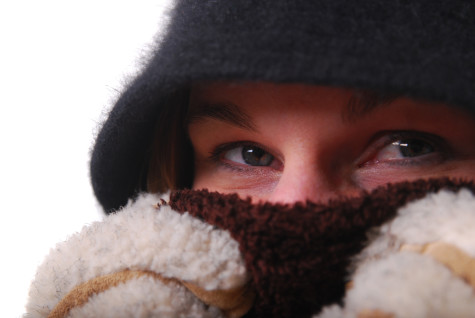A little while back I needed a gift for a friend, and I came across some pretty hand-knit gloves at a craft fair that I knew she’d like. They were fingerless but still quite warm and they’d go nicely with the wooly shawl I’d gotten her the year before.
Never mind that it was the middle of summer. I was sure she’d be wearing them every day anyway. At the office.
You know what I’m talking about. Visit any downtown building on a random Tuesday in the summer and go office to office (or cubicle to cubicle) to see men in shirtsleeves happily working away and women mummified in shawls and sweaters while trying to type in mittens. I’ve worked in many offices (I was a temp for a time) and this has always been the case.
Think about it: Have you ever seen a man’s office chair with a cardigan thrown over the back of it? Or a dude at a board meeting talking over a triple-wrapped scarf? If there’s a guy out there right now sitting at his desk with a wool blanket over his lap, please reveal yourself. We’d like to hug you (and absorb some of your warmth).
So I was happy to read this week that someone—two men, ironically—decided to find out why so many businesses freeze out women while men walk around completely comfortable. The mysterious part isn’t why women are cold and men aren’t. That’s simple metabolic physiology, as when my husband and I walk the dogs together in the fall, him in shorts and a tee shirt and me shivering in long underwear, jeans, sweatshirt, scarf, and ski hat.
The real question is, who decided, and based on what misogynistic information, where to set the working world’s collective thermostat?
It turns out there’s a mathematical formula developed in the 1960s based in part on data about men’s metabolisms that is still being used to determine just how miserable women will be at work. Now, back then there weren’t as many women toiling away at offices, so perhaps the methodology made sense. But I’m certain that the powers-that-were weren’t worrying whether Doris, secretary to Mr. Adams, generated less heat and exposed more leg than a middle-aged middle-weight middleman.
The equation, for those who like that sort of thing, is below.
If you really want more details and explanation of variables and all that, please look them up elsewhere.
Back to my point. There are a lot of us girls working in offices now—about half the workforce, in fact—yet it took nearly half a century of shivering before someone thought to revisit the magic formula, or at least to tell us about it. According to the new study, which actually tested living women, setting thermostats by this law means overestimating the “resting heat production” of women by up to a third.
So, now we know.
Maybe good will come of this knowing. Maybe companies will take note and women of the future won’t have to wear wool underwear to work. Perhaps change is just around the cubicle. Turning down the AC (as in, turning up the temperature) is good anyway, for company bottom lines and for the environment—think of all the energy savings if every building set their dials a little higher. Tap ’em up just a few degrees and everybody wins. (Except maybe men in suits.) (Consider it payback.)
This is all fine and good. But it’s too late to help me. I spent years freezing my ass off at work. I paid my dues.
Fortunately, now, I work from home. I’m old and wise and experienced enough to get my job done without commuting to a city building and doing that job wrapped in a blanket while on public display. My thermostat is mine to adjust and my blankets can stay on my bed.
Which has become more important than I ever thought it could.
Because, recently, as a woman fast approaching a certain age, I’ve been suffering from hot flashes.
(Irony really is super bitchy.)
Hot flashes seem to be more of a mystery than office thermostat settings. Not everyone agrees, but many experts say that reduced estrogen production in middle-aged women causes the brain to detect too much body heat. Hormones then go into action, trying to cool the body down; heart rate rises and blood vessels close to the skin dilate (to allow more blood flow to dissipate the heat), leading to flushing and sweating. Most women get them at some point, and they can plague us for more than seven years. Good times.
How does one feel? Worse than it sounds. Hot Flash sounds like a really sexy superhero. A hot flash feels the opposite of sexy. It’s a sudden wave of stinging damp heat that covers your face like a mask and hugs your body like a tight jumpsuit. You’ve been dropped into a sauna fully clothed; you break out in a sweat in an instant. It can happen anytime and may last one minute or many. Sometimes, for me, it’s strictly an upper body phenomenon, including prickly, sweaty wrists and hands (weird), but other times the heat runs head to toe. Suddenly sweaty legs feel especially unpleasant.
The worst ones come at night: You wake up with your nightgown glued to your back and your face burning, and you kick away the covers maniacally—they can’t be off you fast enough. You pant a bit, holding your hair off your neck, waiting for it to pass. It will. But really, now you need to get up and splash off—at least your face— and maybe even change your PJs and your pillowcase. But if you do all that, you’ll be even more wide awake than you already are, and chances are another flash is en route. No wonder we’re moody. Being a girl has a few perks, but the downsides are steep.
The point of all this? If you’re a young woman, and if your employer doesn’t care to turn the AC off the “icy” setting, enjoy it. Hell, strip off a layer or two and revel in your goose bumps for as long as you can. Because soon enough your own body, the one you’ve nursed and groomed and cared for all this time, is going to turn that dial to an unbearable number—over and over again, for years on end—just to let you know who’s really boss.

All Photos: Shutterstock


I would be remiss not to update with a more in-depth look at this office-temp news. Nothing is as simple as it seems. https://www.sciencenews.org/blog/scicurious/building-standards-aren%E2%80%99t-blame-chilly-offices